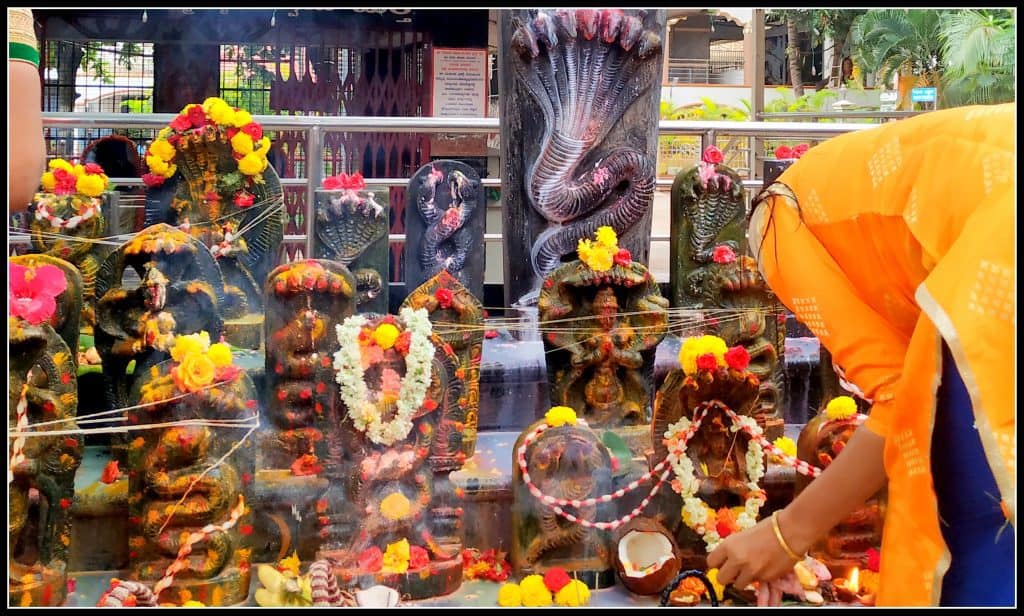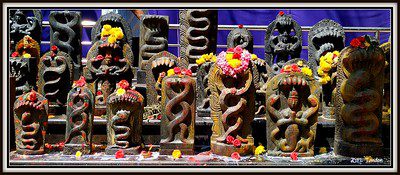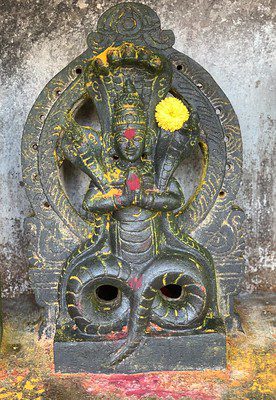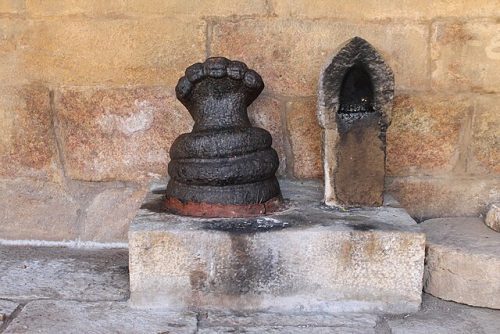Journey through India’s Famous Snake Temples, discovering sacred rituals, age-old myths, and the deep-rooted cultural significance of snake worship in India’s spiritual landscape.

In the vibrant tapestry of Indian culture, few creatures command as much reverence and mystique as the snake. Revered in myths, legends, and religious texts, snakes hold a powerful place in the spiritual landscape of India. They are not merely seen as reptiles but as divine beings symbolizing power, fertility, and protection.
The serpent, or “Naga,” is woven into the fabric of India’s spiritual consciousness, often associated with Lord Shiva and Lord Vishnu, who are depicted with snakes as their companions. This deep-seated reverence has given rise to numerous temples dedicated to snake deities, where devotees flock to seek blessings, protection, and prosperity.
Across the length and breadth of the country, these snake temples in India stand as significant centres of worship, attracting devotees who honour the serpent gods through rituals that have been passed down through generations. The snake, with its ability to shed its skin, is seen as a symbol of renewal and transformation, embodying the cycle of life, death, and rebirth. In many regions, particularly in South India, the serpent is also revered as a guardian of the land, believed to bring fertility to the soil and prosperity to the people.
Why do Hindus worship Snakes?
Snakes hold a significant place in Hindu culture, deeply influencing religious practices and beliefs. Integral to various religions, mysticism, and sacred rituals, the worship of snakes likely originated in India. The Sanskrit word “Sarpam” and the term “Naga” both mean serpent or snake. But why do Hindus worship snakes?

In Hindu mythology, snakes are depicted in multiple forms, including gods, demigods, and even demons. Lord Shiva, one of the principal deities, is often shown with a snake coiled around his neck, symbolizing power and protection. Similarly, Lord Vishnu, another revered deity, is depicted reclining on a thousand-headed serpent called Shesha. These depictions emphasize the omnipresence and protective nature of snakes in Hindu iconography.
Snakes are seen as symbols of power, protection, and fertility in Hinduism. They are believed to be the guardians of the Earth’s treasures and, in some traditions, protectors of the underworld. Many Hindus worship snakes to seek protection from harm and to attract good fortune. However, snakes also represent a darker aspect of Hinduism, symbolizing temptation, deception, and chaos.
The cultural significance of snakes extends to various Hindu festivals and practices. For instance, Nag Panchami is a festival celebrated in many parts of India where people worship snakes to seek their protection and blessings. In Hindu belief, harming or killing a snake is considered a grave sin, potentially leading to bad luck or misfortune. Snakes are also thought to have the power to grant fertility and protect children, leading many Hindus to keep snake figurines in their homes to ward off evil spirits.
Famous Snake Temples:
Mannarasala Sree Nagaraja Temple, Kerala – one of India’s famous snake temples
Mannarasala Sree Nagaraja Temple, located in Kerala, is a renowned pilgrimage site dedicated to Nagaraja, the King of Serpents. According to legend, the temple was established by a Brahmin woman who, with the blessings of Nagaraja, bore children after long being childless. The temple is unique for its rituals, particularly the offering of turmeric, which is believed to possess healing properties and is a symbol of fertility.
Women devotees play a central role in the temple’s rituals, with the temple’s chief priestess, known as the “Mannarasala Amma,” being a woman. She leads the temple’s ceremonies and oversees the observance of traditions, reflecting the temple’s deep connection with feminine energy and fertility. This emphasis on female devotees underscores the temple’s belief in the nurturing and protective aspects of the serpent deity.
Mannarasala Sree Nagaraja Temple is located in Haripad, a town in the Alappuzha district of Kerala. The temple is not only a significant pilgrimage site but is also surrounded by several other attractions. Nearby, you can explore the beautiful Alappuzha Beach, known for its picturesque views and serene atmosphere.
The Krishnapuram Palace, a historical monument, is another attraction close to the temple, showcasing Kerala’s rich cultural heritage and architecture. Additionally, the Karumadi Kuttan, a historic statue of Buddha, is a short drive away and offers a glimpse into the region’s ancient Buddhist history. These sites, along with the tranquil backwaters of Alappuzha, visit Mannarasala Sree Nagaraja Temple a culturally enriching experience.
Kukke Subramanya Temple, Karnataka – one of India’s famous snake temples
Kukke Subramanya Temple, located in the town of Subramanya in the Dakshina Kannada district of Karnataka, is one of the most revered temples in South India. The temple is dedicated to Lord Subramanya, also known as Kartikeya, the god of war and son of Lord Shiva. According to legend, Lord Subramanya offered protection to the serpent king Vasuki from the wrath of Garuda, the eagle deity. As a result, the temple is closely associated with serpent worship, and devotees believe that it holds special significance for those seeking relief from snake-related curses.
One of the temple’s most important rituals is the ‘Sarpa Samskara,’ a unique ceremony performed to alleviate the effects of Sarpa Dosha, a curse believed to result from harming serpents in past lives. Devotees who suffer from issues related to snake bites or infertility often undertake this ritual, which is believed to cleanse the individual of the curse and bring about positive changes in their life.
The temple is situated amidst the lush greenery of the Western Ghats, offering a serene and spiritual environment. Nearby attractions include the scenic Kumara Parvatha, a popular trekking destination, and the sacred Kumaradhara River, where pilgrims take a holy dip before entering the temple. The temple is also close to the Bisle Ghat viewpoint, known for its breathtaking views of the surrounding hills and valleys, visiting Kukke Subramanya Temple a spiritually and naturally enriching experience.
Sri Nagareshwara Temple, Bangalore, Karnataka – one of India’s famous snake temples
Sri Nagareshwara Temple, located in Bangalore, Karnataka, stands as a testament to the enduring cultural beliefs surrounding snake worship in an urban setting. This ancient temple, believed to have been established centuries ago, holds deep historical significance as a centre for the worship of serpent deities. In the bustling city of Bangalore, the temple serves as a spiritual refuge, where the age-old traditions of serpent worship continue to thrive amidst rapid modernization.
The temple is particularly vibrant during festivals like Nag Panchami, a day dedicated to the worship of snakes. On this occasion, devotees flock to the temple to perform special rituals, including the offering of milk, flowers, and turmeric to the serpent idols. These rituals are believed to invoke the blessings of the serpent gods, ensuring protection from snake-related fears and bringing prosperity and fertility to the devotees.
Situated in Bangalore, a city known for its blend of tradition and modernity, Sri Nagareshwara Temple is surrounded by numerous attractions. Visitors can explore the historic Bull Temple, located nearby, which is famous for its giant Nandi statue. The beautiful Lalbagh Botanical Garden, a haven of greenery in the city, offers a peaceful retreat for nature lovers. Additionally, the bustling markets of Bangalore, such as KR Market, are not far from the temple, providing a glimpse into the vibrant local culture. A visit to Sri Nagareshwara Temple not only offers spiritual solace but also a unique perspective on how ancient traditions continue to coexist with the fast-paced life of a modern metropolis.

Kalahasti Temple, Andhra Pradesh -one of India’s famous snake temples
Kalahasti Temple, located in the town of Srikalahasti in Andhra Pradesh, is one of the most revered temples in South India, particularly known for its association with the shadow planets Rahu and Ketu, symbolized by serpents in Hindu astrology. These two celestial bodies are believed to have a profound influence on human lives, often causing disruptions and challenges. The temple is renowned for the unique Rahu-Ketu Dosha Nivarthi ritual, which is performed by devotees seeking to mitigate the adverse effects of these planets in their astrological charts. This ritual involves specific prayers and offerings that are believed to neutralize the malefic influences of Rahu and Ketu, bringing peace and prosperity to the devotee’s life.
Srikalahasti is a historic town situated near the sacred Tirupati, making it an essential stop for pilgrims visiting the region. The temple itself is an architectural marvel, with intricate carvings and a towering gopuram that attracts visitors from across the country. Nearby, visitors can explore other significant sites such as the Tirumala Venkateswara Temple, one of the most visited pilgrimage sites in India, and the Talakona Waterfalls, known for their natural beauty and serene environment. Local beliefs emphasize that the divine presence at Kalahasti Temple is so powerful that it can help overcome severe astrological challenges, particularly those associated with Rahu and Ketu, making it a vital spiritual destination for many.

Adi Sesha Temple, Tamil Nadu– one of India’s famous snake temples
Adi Sesha Temple in Tamil Nadu is a revered spiritual site dedicated to Adi Sesha, the king of all Nagas and the divine serpent on whom Lord Vishnu rests. Adi Sesha holds immense significance in Hindu mythology, symbolizing the eternal cycle of creation, preservation, and destruction. The temple’s unique architecture is a remarkable reflection of this symbolism, with its intricate design mirroring the coiled form of a serpent. The temple’s sanctum is shaped in a way that evokes the image of Adi Sesha’s majestic coils, offering a powerful visual connection to the deity’s protective and all-encompassing nature.
In the spiritual landscape of Tamil Nadu, the Adi Sesha Temple occupies a vital place, drawing devotees who seek the blessings of the serpent king for protection, health, and spiritual wisdom. The temple is not only a place of worship but also a site of deep cultural heritage, where rituals and ceremonies are performed with great devotion, reflecting the region’s rich religious traditions. The temple’s serene atmosphere, combined with its architectural grandeur, makes it a significant pilgrimage destination, reinforcing Tamil Nadu’s status as a land steeped in spiritual and cultural richness.
The enduring legacy of snake worship in India reflects the deep-rooted spiritual and cultural traditions that have shaped the country for millennia. Temples like Adi Sesha in Tamil Nadu, along with other sacred sites dedicated to serpent deities, continue to play a crucial role in preserving these ancient beliefs. They serve as living monuments to the reverence that countless generations have held for the mysteries of life, death, and the natural world, as symbolized by the serpent.
As guardians of cultural continuity, these snake temples invite us to explore the layers of meaning within India’s religious landscape, fostering a deeper appreciation for the diverse ways in which spirituality is expressed across the country. By honouring these traditions, we not only preserve the past but also enrich our understanding of the present and the future of spiritual practice in India.
Some Facts About Snake Worship in India
- Mythological Roots: Hindu mythology is rich with tales of serpent gods and goddesses, known as Nagas, who are revered in various forms across the Hindu pantheon.
- Festivals Celebrating Serpent Worship: Nag Panchami, celebrated in many parts of India, and Ayilyam Pooja in Kerala are two major festivals that draw large crowds of devotees to snake temples, highlighting the deep-rooted cultural significance of snake worship.
- Symbolism of Snakes: Across India, there is a widespread belief that snakes symbolize rain, fertility, and prosperity. This belief connects them to agricultural prosperity and the well-being of communities.
- Unique Rituals at Mannarasala Temple: The Mannarasala Temple in Kerala is particularly unique, where rituals are performed by hereditary women priests. This temple is home to over 30,000 stone-carved snake images, making it a significant pilgrimage site.
- Hope for Childless Couples: Mannarasala Temple is especially revered by childless couples who visit from all over Kerala, other states, and even overseas, trusting in the temple’s deity to bless them with a child.
- Traditional Snake Offerings: Devotees offer a variety of items to the snake deities, including a mix of rice flour and milk (known as Nurum Palum), cooked rice, and a red fluid made from lime and lemon, each symbolizing the deep respect and reverence for these ancient beings.
Read more: Latest



